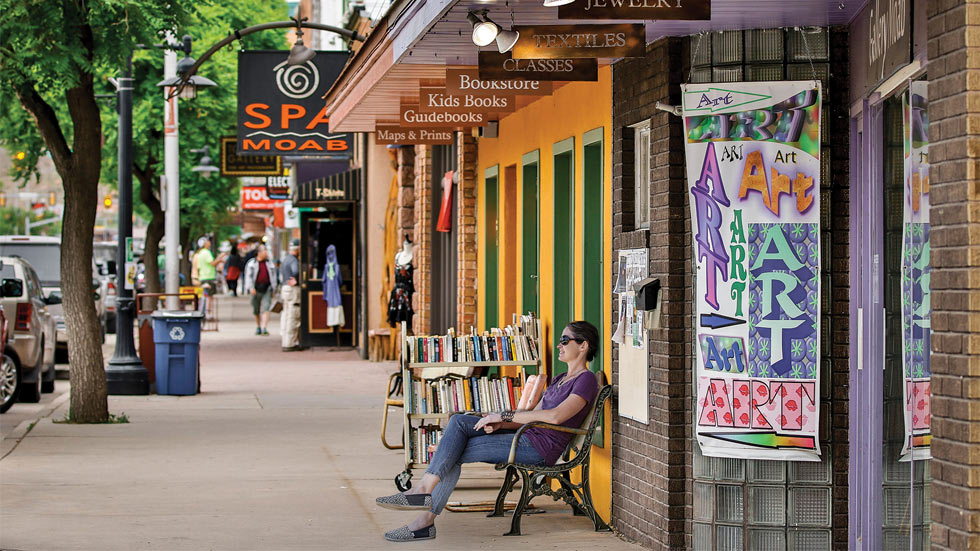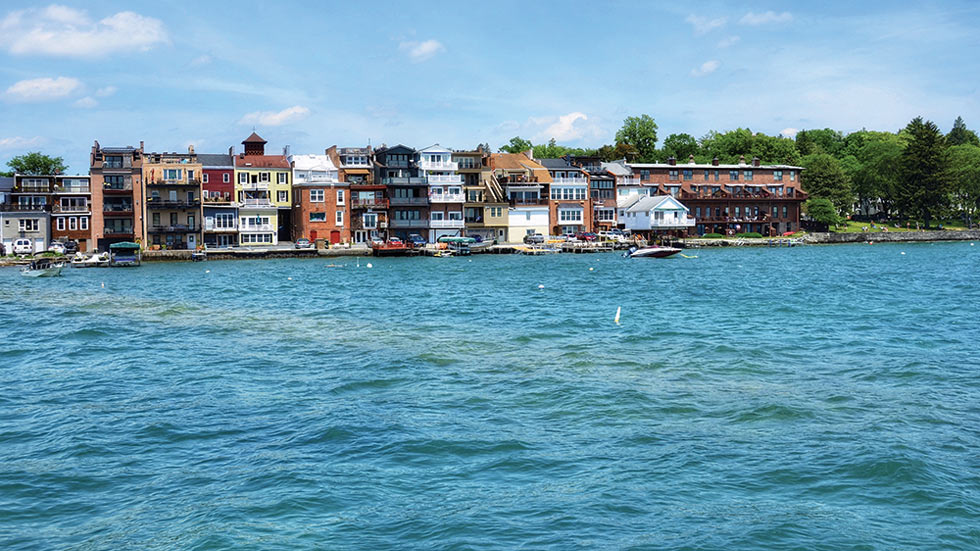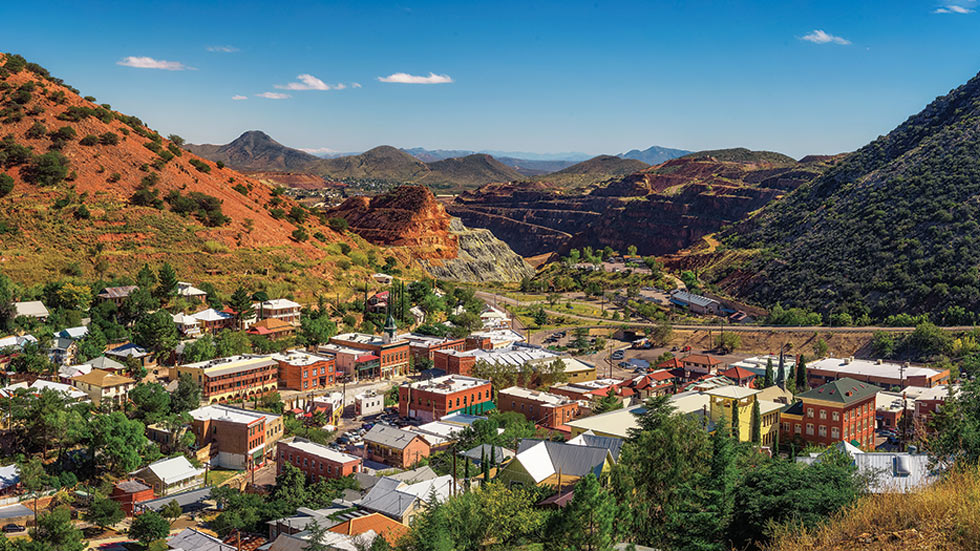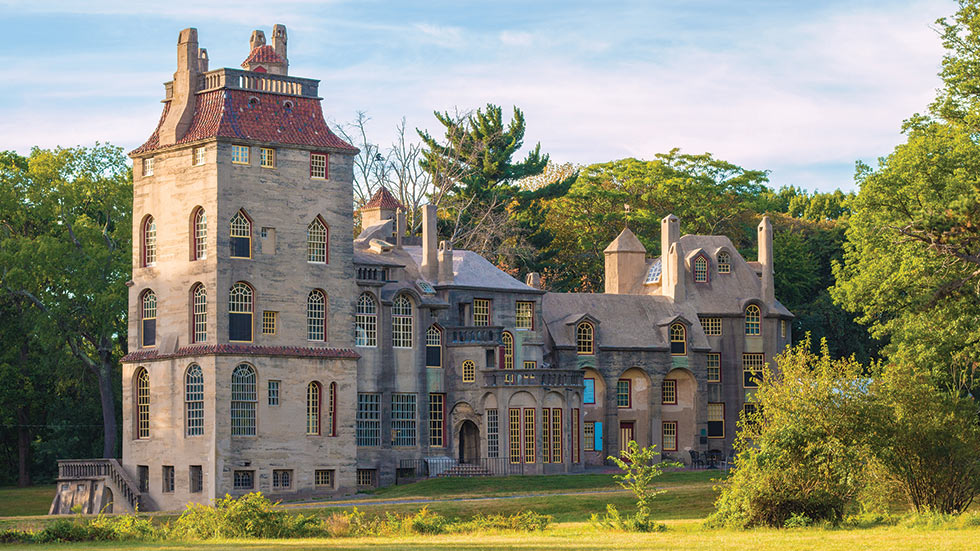Five Small US Towns To Discover
Five small wonders right here in the US that you’ll be glad are now on your radar

In a world in which bigger is often better, today’s travelers are discovering that small towns hold wide appeal with a host of attractions and scenic beauty galore. Authentic, accessible and affordable, these destinations may sit in the shadow of their bigger sisters, but they shine no less bright. Their brilliance attracts travelers in search of fewer crowds and more opportunities to discover new favorite places. We’ve rounded up five small towns across the country that deliver big returns on leisure travel.

Main Street in downtown Moab; Photo by Marc Piscotty
Moab, Utah
Once a mining outpost in southeast Utah, Moab is now known as an adventure epicenter in the middle of nowhere. On the banks of the mighty Colorado River, the town sprouts from the desert like an oasis, complete with trendy Southwest art galleries, patio restaurants, breweries and a slew of outdoor shops huddled along Main Street, the sole thoroughfare connecting the town to the outside world.
Moab’s main attraction is that of a base camp for exploring the astounding spectacles of national parks in the region. Top billing goes to Arches National Park, a vast 76,518-acre slab of eroding sandstone containing the world’s largest concentration of natural arches—more than 2,000 of them. In the recesses of Arches and nearby Canyonlands National Parks, you’ll discover protected Native American cliff dwellings, attendant artifacts, dinosaur tracks and other Jurassic-era reminders documented by park rangers for public viewing.
Mountain biking is a top pursuit, largely due to the rolling, wavelike red rock terrain that provides grip on climbs that would be impossible otherwise. The premier route is the famous Slick Rock Trail, a 12-mile beast that has humbled many a rider (a nearby beginner’s route is recommended for novices). With the roily Colorado River flowing just outside town, river rafting trips are always a hit. Embark on half- or full-day trips in which the grand scene of towering 1,000-foot canyon walls rising up from the river can seem overwhelming. Jeep tours through the labyrinthine red rock canyons are another popular diversion; the better tours include knowledgeable guides who can recount the area’s prehistoric and Native American history.
For a less-strenuous adventure, hot-air ballooning offers surreal views of the chaotic desert geology. Or venture on a scenic 14-mile drive on Utah Highway 12 along the Colorado River to Castle Creek Winery. This retreat provides the perfect finale as you relax on an overlook of the river’s gnarly whitewater rapids at the foot of soaring red rock cliffs while imbibing in local wine.

Columbia River Gorge National Scenic Area; Courtesy of Visit Hood River
Hood River, Oregon
Often overshadowed by Portland, just 63 miles to the west, Hood River is a gateway to some of Oregon’s best natural attractions. Sitting along the Oregon and Washington border, it lies at the confluence of the Columbia and Hood Rivers and within the impressive Columbia River Gorge National Scenic Area, an 85-mile chasm up to 4,000 feet deep.
From a distance, the town of Hood River looks like a misplaced Swiss village poking out from verdant forests, with the craggy backdrop of 11,240-foot Mount Hood dominating its southern skyline. Over the past couple of decades, its downtown has morphed into a trendy wellspring of visual and performing artists, design professionals and other creative types drawn by the work-hard, play-hard outdoors-oriented culture.
Minutes from town, you can engage in a number of outdoor activities, including hiking, paddle boarding, skiing, mountain biking and fishing. From the slopes of Mount Hood Meadows Ski Resort less than an hour away, you’ll be wowed by stunning panoramas year-round, not to mention 87 ski and snowboard runs and what’s widely recognized as perhaps the state’s best intermediate and beginner terrain.
Foodies and wine and beer lovers alike will rejoice here, too, as the town sits in the middle of the state’s orchard country. One of the best ways to experience the bounty of the area’s farms, orchards and vineyards is a leisurely journey by car or bicycle along the Hood River Fruit Loop. The scenic 35-mile route loops through farmland and forests, allowing you to sample a cornucopia of apples, peaches, blueberries, pears and cherries at more than two dozen participating farm stands. There are even a few lavender farms mixed in.
The region is chock-full of wineries, small artisan breweries and even a few cideries that have opened in the past few years. Prime season on the loop is June to November, when most of the farm stands are open. Wineries take center stage from November to March.

Boat tours lead past charming properties on Skaneateles Lake; Photo by RedBridge/stock.adobe.com
Skaneateles, New York
At the turn of the 19th century, the Finger Lakes District of Central New York became a noted vacation destination for New York City’s burgeoning leisure class. On the northern shores of its eponymous lake—one of 11 Finger Lakes in the state—the village of Skaneateles was and still is an archetype of the region, renowned for its amalgam of historic preservation, Victorian charm, hospitality, gorgeous scenery, seasonal activities and cultural attractions.
Much activity centers on the many ways to enjoy Skaneateles Lake, a 16-mile-long aquamarine jewel bounded by low hills and dense woods and among the cleanest lakes in North America. Your first order might be a stroll on the Skaneateles Pier to take in lake views, followed by a private boat excursion with Mid-Lake Navigation, whose guides narrate local history and landmarks with a mix of knowledge and humor. Along the lakeshore, you’ll see the many old refurbished cottages and sprawling estates. One of the more notable of these is Fall Brook Point, where in 1836 American artist Charles Loring Elliott painted A View of Fall-Brook Falls near Skaneateles. Elliott became one of the nation’s most respected and popular portrait painters, completing more than 700 commissions.
Genesee and Jordan Streets compose the core of the Skaneateles Historic District, which boasts some structures dating to 1796. Today, those buildings house a wonderful array of shops, boutiques, galleries and restaurants. Culture and the arts are emphasized here. Summer brings festivals, band concerts at the Clift Park Gazebo, carriage rides and culinary events. The holiday season features the annual Dickens Christmas, followed by Winter Fest in late January. Roam the outlying areas to explore dozens of wineries and small farms dotting the rolling landscape.

Panorama of Bisbee and Mule Mountains; Photo by Nick Fox/stock.adobe.com
Bisbee, Arizona
Perched on a mountainous sky island 90 miles southeast of Tucson, this former mining town turned art colony is known for its art scene and impeccably preserved Victorian buildings. Bisbee was once among the richest mining towns in the world, producing nearly three million ounces of gold and more than eight billion pounds of copper from mines bored into the local Mule Mountains. After the riches dried out and miners packed their bags in the mid-1970s, Bisbee saw an influx of artists and free spirits attracted to its historic downtown and the 5,538-foot elevation that provides cool relief from the Sonoran Desert.
Walking along Bisbee’s steep, winding narrow streets and alleys, you’ll find a constellation of galleries, boutiques, eateries, whimsical wooden hotels and bed-and-breakfasts, all beautifully preserved as reminders of Bisbee’s mining heyday. Since flat ground is rare in this mountainside town, you’ll likely navigate some of the 350 historic Heritage Stairs that enabled miners to reside near their mines. Once you’ve explored Bisbee by foot, give yours a rest by hitching a ride on the Queen Mine Tour, where visitors don a miner’s headlamp, ride a mine train 1,500 feet into the famous copper ore mine, and delve deep into local history and the lives of miners.

Fonthill Castle showcases Henry Chapman Mercer’s collection of tiles and prints. Courtesy of Visit Bucks County
Doylestown, Pennsylvania
Named “one of America’s [Top 20] Favorite Towns” by Travel + Leisure in 2013 and recognized by USA Today 10Best in 2019 for its “small-town cultural scene,” Doylestown attracts visitors with its rich history, unique attractions and lively downtown set amid bucolic surroundings just 40 miles north of Philadelphia.
Established 275 years ago and bearing a name derived from 18th-century Doyle’s Tavern, which once graced Main Street, the Bucks County seat is renowned for The Mercer Mile, a trifecta of unusual attractions built by an unusual man: archaeologist, artifact collector, tile-maker and architect Henry Chapman Mercer. The treasures include Mercer’s one-time home, Fonthill Castle, an early 20th-century concrete fantasy melding Gothic, Medieval and Byzantine architecture; the adjacent Moravian Pottery and Tile Works, which still produces handmade tiles using a method similar to that developed by Mercer; and the Mercer Museum, a six-story concrete wonderland bursting at the seams with a fantastic hodgepodge of craft and trade tools from pre-industrial America.
Early 20th-century Bucks County also saw an influx of artists, makers and designers, including American Impressionist painters and studio craftspeople whose work can now be seen at the James A. Michener Art Museum (named for author Michener, a Doylestown favorite son). Still beloved by artists, Doylestown and nearby towns boast an abundance of studios and galleries.
Before departing the region, be sure to take a scenic drive along country roads (perhaps crossing one of the county’s 12 covered bridges) and make time for a few stops at the area’s farm markets, wineries, breweries, parks and gardens.
